安捷伦 3000T X 系列示波器说明书
- 格式:pdf
- 大小:6.12 MB
- 文档页数:36
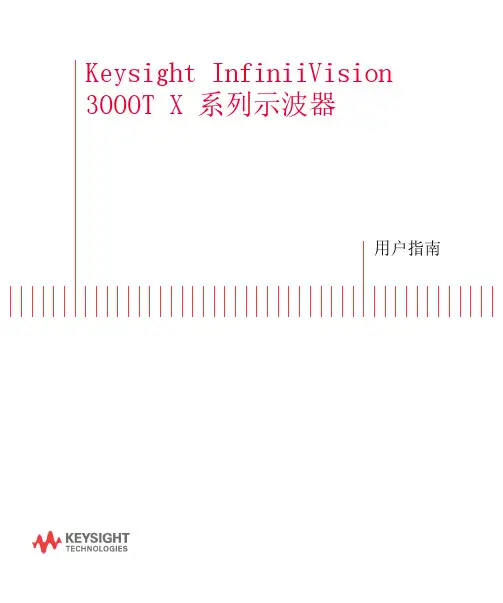
Keysight InfiniiVision 3000T X 系列示波器用户指南声明© Keysight Technologies, Inc. 2005-2022根据美国和国际版权法,未经 Keysight Technologies, Inc. 事先同 意和书面允许,不得以任何形式或通过 任何方式(包括电子存储和检索或翻译 为其他国家或地区的语言)复制本手册 中的任何内容。
手册部件号75037-97089版本第八 版, 2022 年 6 月仅提供电子格式发布者:Keysight Technologies, Inc.1900 Garden of the Gods Road Colorado Springs, CO 80907 USA修订历史75037-97002, 2014 年 11 月75037-97015, 2015 年 8 月75037-97027, 2016 年 7 月75037-97040, 2017 年 11 月75037-97052, 2019 年 5 月75037-97064, 2020 年 10 月75037-97076, 2021 年 10 月75037-97089, 2022 年 6 月担保本文档中包含的材料" 按现状"提供,在将来版本中如有更改,恕不另行通知。
此外,在适用法律允 许的最大范围内,Keysight 不对本手册及其包含的任何信息提供任何明示或暗示的保证,包括但不仅限于对适销性和用于特定用途时的适用性的暗示担保。
对于因提供、使用或运用本文档或其包含的任何信息所导致的错误或者意外或必然损害,Keysight 概不负责。
如果Keysight 和用户之间已达成的单独书面协议包含涉及本文档内容的担保条款,但担保条款与这些条款有冲突,则应以单独协议中的担保条款为准。
技术许可对于本文档中描述的硬件和/或软件,仅在得到许可的情况下才会提供,并且只能根据许可进行使用或复制。

数据手册-2018.04SDS3000X 系列智能示波器数据手册产品综述SDS3000X 系列智能示波器,最大带宽 1GHz,最高实时采样率 4GSa/s,采用创新的 SPO 技术,支持高刷新、256级波形辉度等级及色温显示、数字触发和深存储特性;采用单芯片 ADC,具备优异的模拟前端和信号保真度;支持丰富的智能触发、串行协议触发和解码;支持历史模式(History)、顺序模式(Sequence)、高级波形搜索和分析(WaveScan)、趋势图(Trend)、参数直方图(Histicons)、增强分辨率模式(Eres);具备丰富的测量和数学运算功能;具备独特的综合归档功能(LabNoteBook);支持16路数字通道;集成 25MHz 函数 / 任意波形发生器;配备 Windows 操作系统和10.1 英寸电容触摸屏。
基于以上强大的功能与特性,SDS3000X 可以满足用户日益增长的测试测量和数据分析的需求,是一款性能先进的智能示波器。
特性与优点模拟通道带宽:500MHz、1GHz 4 模拟通道 +1 个外触发通道实时采样率高达 4GSa/s 创新的 SPO 技术 存储深度达 20Mpts/CH 波形捕获率达 1,000,000 帧 / 秒具备优异的模拟前端和信号保真度,最低底噪低于 400μV 支持 256 级波形辉度等级及色温显示配备 Windows 操作系统和 10.1 英寸电容触摸屏(1024*600),支持触摸屏、键盘、 鼠标操作采用顶级的用户界面MAUI,迷人的简洁,所有菜单层级只有两级 集成了 15 种最常用的一键式设计,一触即发智能触发(边沿,脉宽,判定合格,逻辑图,TV,窗口,间隔,漏失,欠幅, 斜率)串行总线触发及解码,支持的协议:I 2C、I 2S、 SPI、 UART/RS232、LIN、CAN、 CAN-FD、 FlexRay、MIL 1553、USB 2.0顺序模式(Sequence),根据用户设置的触发条件,以最小 1us 的死区时 间分段捕获符合条件的事件,并给出时间标签高级波形搜索和分析(WaveScan)功能,支持多种搜索条件,并把捕获的 异常信号用 Zoom 功能展现出来,方便用户在海量信息中快速搜索出需要关 注的波形增强分辨率模式(Eres),通过数字滤波的方式降低噪声带宽,可等效提高 示波器的垂直分辨率,最高可达 11 bit历史模式(History),一键进入,通过导航栏“回放”历史上出现过的波形综合报告归档功能(LabNoteBook), 保存的数据可在示波器和 PC 端进行 再测量和分析24 种参数统计测量和 20 种波形运算,能支持 AIM 测量和波形的运算再运 算(Math on Math)趋势图(Trend),以线图的方式表示参数测量结果随采集的次序变化的过程, 第一次采集的测量结果显示在屏幕的最左边,测量结果从右往左逐渐移动参数直方图(Histicons),反映了参数值在一个确定范围 (Bin) 内出现的概率, 表明了参数值的统计分布状态通过 / 失败(Pass/Fail)检测功能,用户可自定义规则 / 模板,与被测信号 进行比较,实时统计通过 / 失败的次数,可用来查找异常波形或进行自动化测试内置 25MHz 函数 / 任意波形发生器,125MSa/s 采样率,16kpts 波形长度 16 路数字通道(MSO 功能),500MSa/s 采样率,10Mpts 存储深度4 位数字电压表和 5 位硬件频率计功能丰富的外围接口:4*USB Host,SD 卡槽,USB Device,LAN,AUX out (Pass/Fail,Trigger Out),EXT TRIG,标准 D 型 15 针 SVGA 接口(分辨 率 1024*600),16 路逻辑通道接口和可配置的校准信号接口,方便仪器扩 展及程控操作SDS3000X 系列智能示波器数据手册型号与主要指标一键进入运算一键保存一键打印一键清除一键进入历史模式一键调用保存的波形一键复位一键捕获一键放大一键光标一键WaveScan 一键触发点归零同类型500MHzSDS3054XSDS3000X 系列智能示波器数据手册创新的SPO 构架丰富的调试工具包,精确定位问题在实时采样下,SDS3000X 系列最大支持250,000帧/秒的波形捕获率;在顺序模式(Sequence)下,其最高波形捕获率可达1,000,000帧/秒。

安捷伦示波器说明书解决multisim仿真速度慢multisim11.0中仿真时间步长的设定方法multisim10示波器的使用方法——同电子仿真软件MultiSIM 9中的虚拟示波器使用方法2011-06-13 22:16:43| 分类:IC -- 电子| 标签:|字号大中小订阅电子仿真软件MultiSIM 9中的虚拟示波器使用方法朱晓欣(原载《无线电》杂志07年第五期)在电子仿真软件MultiSIM 9中,除了虚拟双踪示波器和虚拟四踪示波器以外,还有两台高性能的先进示波器,它们分别是:跨国"安捷伦"公司的虚拟示波器"Agilent54622D"和美国"泰克"公司的虚拟数字存贮示波器"TektronixTDS2024"。
本刊06年第五期曾对Multisim7中的安捷伦虚拟示波器设置和显示有过简单介绍,读者可以参阅该文相关内容。
本文主要介绍安捷伦虚拟示波器的一些特殊其它功能和美国"泰克"公司的虚拟数字存贮示波器这两台高档次的示波器使用方法。
一、安捷伦虚拟示波器"Agilent54622D"的使用方法举例Agilent54622D虚拟示波器的带宽为100MHz,具有两个模拟通道和16个逻辑通道。
图一是它的放大面板图,它的各个开关、按钮及旋钮的排列和调节都和实物仪器完全一样,我们在自己的电脑里也能享受到使用高档次测量仪器的愉悦,且没有损坏仪器的担忧。
图一一、显示基本波形操作(这里以模拟通道1为例说明)首先在电子仿真软件MultiSIM 9电子平台上调出安捷伦虚拟函数信号发生器和安捷伦虚拟示波器各一台。
并按图二连好电路;双击安捷伦虚拟函数信号发生器图标"XFG1"打开电源开关,不作任何设置使用它的默认值,即:频率1kHz,幅值100mVpp的正弦波(可参阅上期介绍)。
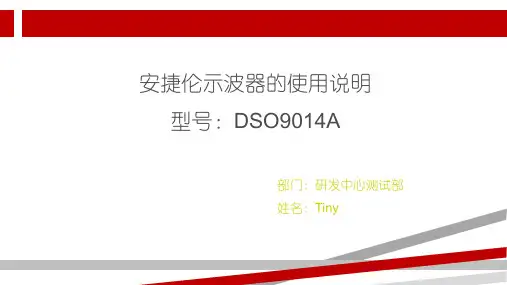

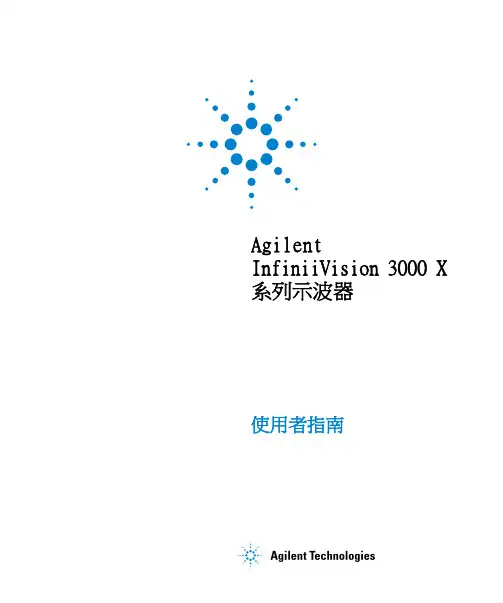
AgilentInfiniiVision 3000X 系列示波器使用者指南s1聲明© Agilent Technologies, Inc. 2005-2012本手冊受美國與國際著作權法之規範,未經 Agilent Technologies, Inc. 事先協議或書面同意,不得使用任何形式或方法 (包含電子形式儲存、擷取或轉譯為外國語言) 複製本手冊任何部份。
手冊零件編號75019-97054版本第五 版, 2012 年 3 月馬來西亞印製Agilent Technologies, Inc.1900 Garden of the Gods Road Colorado Springs, CO 80907 USA 保固本文件所含內容係以「原狀」提供,未來版本若有變更,恕不另行通知。
此外,在相關法律所允許之最大範圍內,Agilent 不承擔任何瑕疵責任擔保與條件,不論其為明示或暗示者,其中包括 (但不限於) 適售性、適合某特定用途以及不侵害他人權益之暗示擔保責任。
對於因提供、使用或運用本文件或其中所含的任何內容,以及所衍生之任何損害或所失利益或錯誤,Agilent 皆不負擔責任。
若Agilent 與使用者就本文件所含材料保固條款簽訂其他書面協議,其中出現與上述條款相牴觸之部分,以個別合約條款為準。
技術授權此文件中所述的硬體及/或軟體係依授權提供,且僅可以依據此類授權之條款予以使用或複製。
限制權利聲明美國政府限制權利。
授予聯邦政府之軟體及技術資料僅包含為一般使用者提供的自訂權利。
Agilent 依照 FAR12.211(「技術資料」) 及 12.212 (「電腦軟體」)、國防部 DFARS 252.227-7015 (「技術資料 - 商業條款」) 以及 DFARS227.7202-3 (「商業電腦軟體」或「電腦軟體說明文件」中的權利) 提供此軟體與技術資料之自訂商業授權:安全聲明「注意」標示代表發生危險狀況。

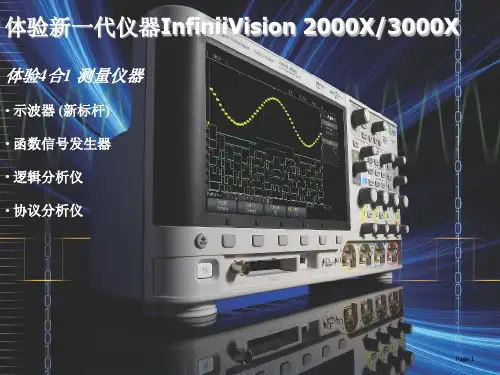
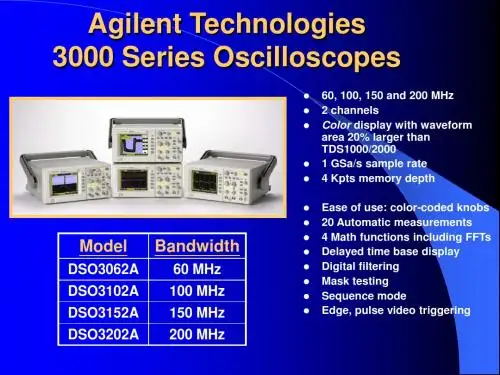
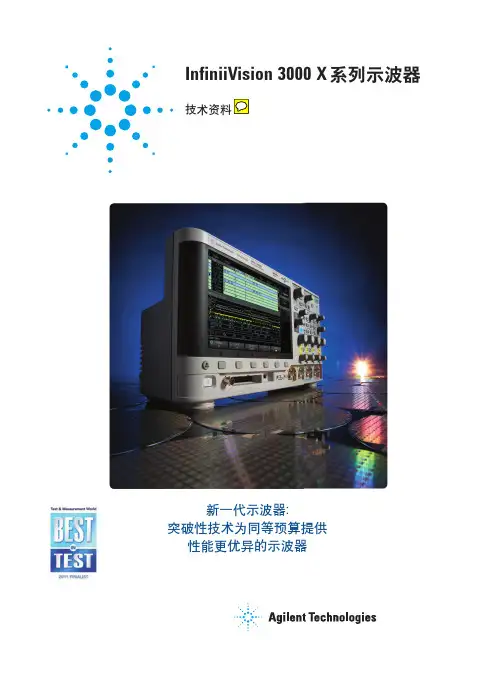
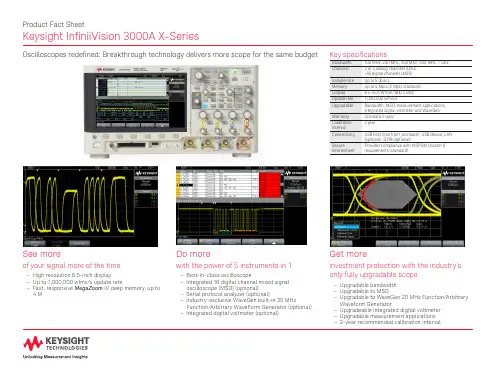
Agilent DSOX3000 FE演示指南基本介绍和设置目的和说明这个演示指南主要为分销工程师设计,目标是能独立的为客户做10-20分钟演示,把DSOX3000的一些独特的特点、优势和好处介绍给客户。
需要的设备DSOX3000示波器,两根无源探头N28XXA/B.任务一:示波器基本介绍介绍3000X的一些基本概况.包括:1.5合1设备,即是一台综合示波器,逻辑分析仪,协议分析仪,任意波形发生器,电压表和频率计为一体的综合性设备.根据客户应用情况,针对5合1中的子设备功能做重点介绍。
要点:示波器主要型号,带宽,主要采样率指标,带宽可升级,波形捕获率,强大的触发功能等;MSO的基本指标,采样率,存储深度;协议分析仪支持的串行总线种类,硬件协议触发和解码;任意波形发生器,支持的信号类型和最高频率;电压表和频率计的基本指标。
2.对产品的简洁外形做一简单介绍.3. 针对每个子设备功能能熟练的做自动演示。
任务二:100万次/秒的波形捕获率,信号捕获和触发介绍简介中低端示波器日常主要应用为通用信号调试和观察,因此如何演示3000X的调试和捕获功能无疑是非常重要的.此任务演示主要和TEK DPO3000/4000演示对应,需要展示出3000X在调试能力方面全面超越DPO3000/4000的特点.首先请按自动演示介绍DSOX3000 100万次/秒波形捕获率及与其它竞争对手产品指标差异及对比效果。
其次,采用内部信号做模拟实测演示。
设置步骤:1.连接通道1到Demo1端子和地,通道2到Demo2端子和地。
2.按下Default Setup.按下Help,然后按下培训信号软键,旋转多功能旋钮选择带偶发毛刺的时钟信号,按下右下角输出按钮。
可以看到如下波形:3.调节垂直和水平档位及触发到500mV/Div,20ns/Div,边沿触发在1V/Div,得到如下波形:这时可以看到偶发毛刺信号在闪烁,并强调DSOX3000 业界领先的100万次/秒的波形捕获率可以最快看到这一偶发信号。
Agilent Technologies 3000 Series Oscilloscopes Data SheetGet more for your moneyAgilent’s 3000 Series oscilloscopes give you an affordable way tosee what’s happening in your designs. Developed with the features you need to make your job easier – including a large LCD color display. Need flexibility? Choose from four models with bandwidths ranging from 60-MHz to 200-MHz. To give you the debugging power you need, each oscilloscope comes standard with advanced features including sophisticated triggering, automatic measurements,digital filtering, sequence mode acquisition,math functions (including FFTs), stored setups and waveforms, mask testing and much more.Full-featured oscilloscopes for the smallest budgetsFeatures:• 60 to 200 MHz bandwidths• 1 GSa/s maximum sample rate• Large 15-cm (5.7-in) color display• Advanced triggering includingedge, pulse width, and line-selectable video• 4 kpts of waveform memory• USB host and device connectivity,standard• 20 automatic measurements plushardware counter and Measure All• Four math functions, includingFFTs standard• Mask test standard• GPIB and RS-232 connectivity andSCPI programming available withN2861A communications module• Interface localized into12-languages• Sequence mode (segmentedmemory) standardSee your signals more clearlyAll 3000 Series models have color Array displays to allow you to quicklyidentify your signals, and thelarge size – 15-cm (5.7-in) with320 x 240 resolution – makesit easier for you to see moreinformation.The 3000 Series’ delayed sweepalso lets you see more details inyour design. You can view a longrecord, then window in on thesection of the signal of interest.Figure 1. All 3000 Series oscilloscopes come standard witha color display and cost 20% less than competitive products.The color display allows you to quickly and easily identify yoursignals and view signal activity. ArrayFigure 2. Want to see the big picture but still get all thedetails? Use the delayed sweep mode to zoom in on aparticular area of interest on your signal while still viewingthe entire captured waveform.2The features you needAll 3000 Series scopes include the standard features you need to get your job done easier and faster: Autoscale – Autoscale lets you quickly display any active signals, automatically setting the vertical, horizontal and trigger controls for the best signal display.Easy connectivity – The 3000 Series oscilloscopes come standard with an N2865A USB host module for saving setups, waveforms and displays to a memory stick. This port is also compatible with many USB printers.This scope series also offers Scope Connect software, which provides PC connectivity for data gathering, pass/fail testing, and analysis via the 3000 Series' USB device port.GPIB and RS-232 interfaces are also available with the N2861A connectivity module.Advanced triggering –Includes edge, pulse width and line-selectable video, to help you isolate the signals you want to see.20 automatic measurements – To save time, you can make18 different measurements simultaneously.Figure 3. The 3000 Series comes equipped with a broad set of measurement and math features, including FFTs at no additional cost. You can choose between 4 FFT windows for your specific measurement needs: Hanning, Hamming,Blackman-Harris, and rectangular.Waveform math with FFTs– Analysis functions includeaddition, subtraction,multiplication, and Fast FourierTransforms with four windows(Hanning, Hamming, Blackman-Harris and rectangular).Auto calibration – Automaticallycalibrates the oscilloscope’svertical and horizontal systems.Multi-language interface –Operate the oscilloscope inthe language of your choice.Language support includessimplified and traditionalChinese, Japanese, Korean,French, German, Italian,Portuguese, Russian, Spanishand English.Figure 4. Standard USB host and device ports allow you to send your measurements directly to your PC or save them to Flash memory sticks.34The features you need (continued)Digital filtering – Digital filtering selections include low pass, high pass, band pass, and band reject filters. Limits are selectablebetween 1-kHz and the bandwidth of your oscilloscope model.Ten waveform and setupmemories – Store waveforms or commonly used setups for future reference and use.Mask testing – Automatically compares incoming signals with a pre-defined mask, clearly highlighting signal changes.Sequence mode (segmented memory) – Frame an area of interest on your signal for acquisition and record up to 1,000 frames for playback.Pulse triggering – Lets you trigger on pulse events.3-year warranty – All 3000Series scopes include a full 3-year warranty.Easy to set up and use– Dedicated, color-coded knobs for vertical sensitivity, offset, and time base settings make it easy to set up and use. Front-panel keys for triggering functions are alsogrouped to make your job easier.Figure 7. With dedicated, color-coded knobs and front-panel keys grouped by function, it is easy to find and use all of the features of the scope – from the most basic to the more advanced functions.Figure 5. The digital filter capability enhances your ability to examine important signal components by filtering out undesired spectral components such as various typesof noise.Figure 6. Use the sequence mode to frame an area of interest on your signal for acquisition; then, use the playback feature to quickly play through the sequence andeasily spot glitches or other signalanomalies.Performance characteristics567Ordering information89Ordering information(continued)To get a Quick Quote on Agilent3000 Series oscilloscopes, go to /find/dso3000Call the measurement experts at Agilent TechnologiesWhether your work is mostly digital, mostly analog, orsomewhere in the middle, our measurement specialists can help you select the best debugging solution. Call today to talk to a knowledgeable engineer about your particular application.10Agilent Technologies OscilloscopesMultiple form factors from 20 MHz to >90 GHz | Industry leading specs | Powerful applications。
DSOX3PWR 功率量測應用使用者指南s1聲明© Agilent Technologies, Inc. 2007-2009, 2011-2012本手冊受美國與國際著作權法之規範,未經 Agilent Technologies, Inc. 事先協議或書面同意,不得使用任何形式或方法 (包含電子形式儲存、擷取或轉譯為外國語言) 複製本手冊任何部份。
手冊零件編號版本 02.20.0000版本2012 年 7 月 16 日Available in electronic format onlyAgilent Technologies, Inc.1900 Garden of the Gods Road Colorado Springs, CO 80907 USA 保固本文件所含內容係以「原狀」提供,未來版本若有變更,恕不另行通知。
此外,在相關法律所允許之最大範圍內,Agilent 不承擔任何瑕疵責任擔保與條件,不論其為明示或暗示者,其中包括 (但不限於) 適售性、適合某特定用途以及不侵害他人權益之暗示擔保責任。
對於因提供、使用或運用本文件或其中所含的任何內容,以及所衍生之任何損害或所失利益或錯誤,Agilent 皆不負擔責任。
若Agilent 與使用者就本文件所含材料保固條款簽訂其他書面協議,其中出現與上述條款相牴觸之部分,以個別合約條款為準。
技術授權此文件中所述的硬體及/或軟體係依授權提供,且僅可以依據此類授權之條款予以使用或複製。
限制權利聲明美國政府限制權利。
授予聯邦政府之軟體及技術資料僅包含為一般使用者提供的自訂權利。
Agilent 依照 FAR12.211(「技術資料」) 及 12.212 (「電腦軟體」)、國防部 DFARS 252.227-7015 (「技術資料 - 商業條款」) 以及 DFARS227.7202-3 (「商業電腦軟體」或「電腦軟體說明文件」中的權利) 提供此軟體與技術資料之自訂商業授權:安全聲明注意「注意」標示代表發生危險狀況。